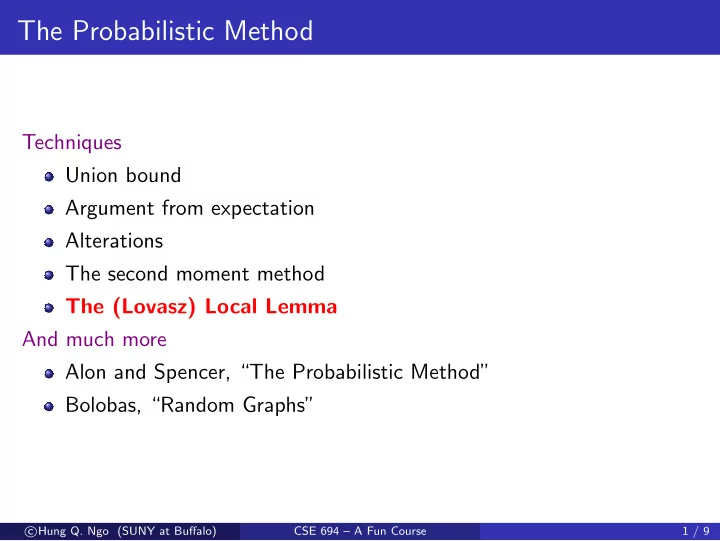

The Probabilistic Method Techniques Union bound Argument from expectation Alterations The second moment method The (Lovasz) Local Lemma And much more Alon and Spencer, “The Probabilistic Method” Bolobas, “Random Graphs” � Hung Q. Ngo (SUNY at Buffalo) c CSE 694 – A Fun Course 1 / 9
Lovasz Local Lemma: Main Idea Recall the union bound technique: want to prove Prob [ A ] > 0 ¯ A ⇒ (or ⇔ ) some bad events B 1 ∪ · · · ∪ B n done if Prob [ B 1 ∪ · · · ∪ B n ] < 1 Could also have tried to show Prob [ ¯ B 1 ∩ · · · ∩ ¯ B n ] > 0 Would be much simpler if the B i were mutually independent, because n Prob [ ¯ B 1 ∩ · · · ∩ ¯ � Prob [ ¯ B n ] = B i ] > 0 i =1 Main Idea Lovasz Local Lemma is a sort of generalization of this idea when the “bad” events are not mutually independent � Hung Q. Ngo (SUNY at Buffalo) c CSE 694 – A Fun Course 2 / 9
PTCF: Mutual Independence Definition (Recall) A set B 1 , . . . , B n of events are said to be mutually independent (or simply independent) if and only if, for any subset S ⊆ [ n ] , �� � � Prob B i = Prob [ B i ] i ∈ S i ∈ S Definition (New) An event B is mutually independent of events B 1 , · · · , B k if, for any subset S ⊆ [ k ] , � � � Prob B | B i = Prob [ B ] i ∈ S Question: can you find B, B 1 , B 2 , B 3 such that B is mutually independent of B 1 and B 2 but not from all three? � Hung Q. Ngo (SUNY at Buffalo) c CSE 694 – A Fun Course 3 / 9
PTCF: Dependency Graph Definition Given a set of events B 1 , · · · , B n , a directed graph D = ([ n ] , E ) is called a dependency digraph for the events if every event B i is independent of all events B j for which ( i, j ) / ∈ E . What’s a dependency digraph of a set of mutually independence events? Dependency digraph is not unique ! � Hung Q. Ngo (SUNY at Buffalo) c CSE 694 – A Fun Course 4 / 9
The Local Lemma Lemma (General Case) Let B 1 , · · · , B n be events in some probability space. Suppose D = ([ n ] , E ) is a dependency digraph of these events, and suppose there are real numbers x 1 , · · · , x n such that 0 ≤ x i < 1 � Prob [ B i ] ≤ x i (1 − x j ) for all i ∈ [ n ] ( i,j ) ∈ E Then, � n � n � ¯ � Prob B i ≥ (1 − x i ) i =1 i =1 � Hung Q. Ngo (SUNY at Buffalo) c CSE 694 – A Fun Course 5 / 9
The Local Lemma Lemma (Symmetric Case) Let B 1 , · · · , B n be events in some probability space. Suppose D = ([ n ] , E ) is a dependency digraph of these events with maximum out-degree at most ∆ . If, for all i , 1 Prob [ B i ] ≤ p ≤ e (∆ + 1) then � n � � ¯ Prob B i > 0 . i =1 The conclusion also holds if 1 Prob [ B i ] ≤ p ≤ 4∆ � Hung Q. Ngo (SUNY at Buffalo) c CSE 694 – A Fun Course 6 / 9
Example 1: Hypergraph Coloring G = ( V, E ) a hypergraph, each edge has ≥ k vertices Each edge f intersects at most ∆ other edges Color each vertex randomly with red or blue B f : event that f is monochromatic 2 1 2 | f | ≤ Prob [ B f ] = 2 k − 1 There’s a dependency digraph for the B f with max out-degree ≤ ∆ Theorem G is 2 -colorable if 1 1 2 k − 1 ≤ e (∆ + 1) � Hung Q. Ngo (SUNY at Buffalo) c CSE 694 – A Fun Course 7 / 9
Example 2: k -SAT Theorem In a k -CNF formula ϕ , if no variable appears in more than 2 k /e clauses, then ϕ is satisfiable. Recently Moser (and Moser-Tardos) showed how to find such a truth assignment. � Hung Q. Ngo (SUNY at Buffalo) c CSE 694 – A Fun Course 8 / 9
Example 3: Edge-Disjoint Paths N a directed graph with n inputs and n outputs From input a i to output b i there is a set P i of m paths In switching networks, we often want to find (or want to know if there exists) a set of edge-disjoint ( a i → b i ) -paths Theorem Suppose 8 nk ≤ m and each path in P i shares an edge with at most k paths in any P j , j � = i . Then, there exists a set of edge-disjoint ( a i → b i ) -paths. � Hung Q. Ngo (SUNY at Buffalo) c CSE 694 – A Fun Course 9 / 9
Recommend
More recommend